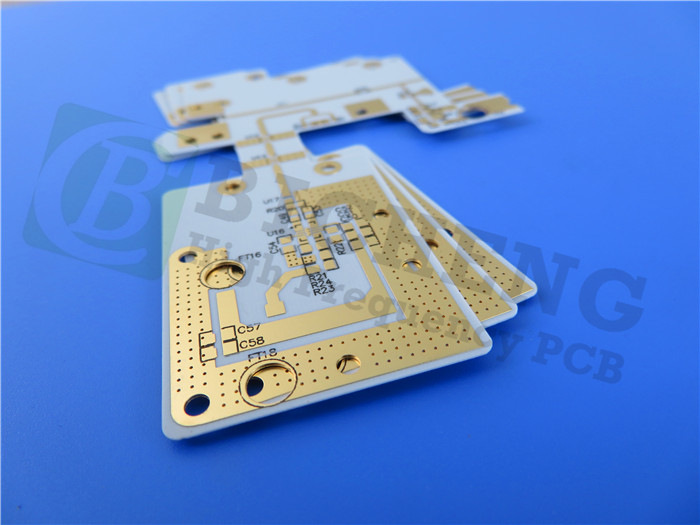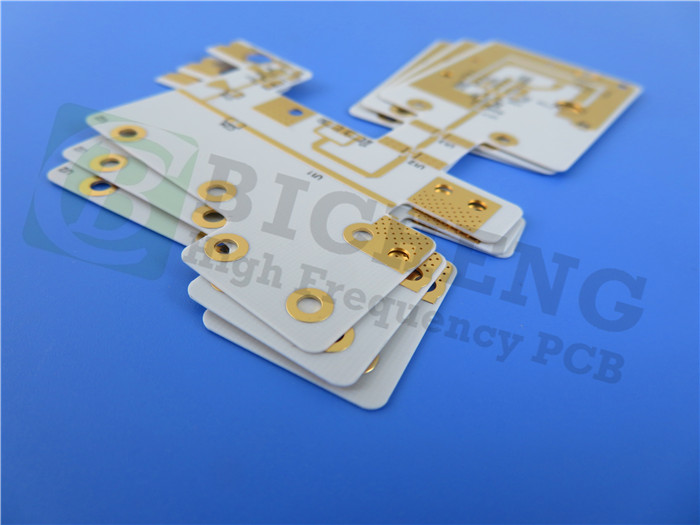In the realm of high-frequency circuit materials,
Rogers RO4830 stands out as a versatile and cost-effective option, offering a compelling alternative to traditional PTFE-based laminates. Engineered to deliver exceptional performance in millimeter wave applications, particularly in the realm of automotive radar sensors operating within the 76-81 GHz spectrum,
RO4830 PCBs embody a blend of reliability, efficiency, and affordability that cater to a wide array of industry needs.
Introduction to RO4830: Redefining High-Frequency Laminates
Rogers RO4830 high-frequency laminates are thermoset materials designed to provide a reliable and cost-effective solution for applications requiring high performance at millimeter wave frequencies. With a slightly higher dielectric constant of 3.2 at 77GHz compared to PTFE-woven glass laminates,RO4830 5mil laminates offer excellent insertion loss characteristics, boasting a remarkable 2.2 dB per inch at 77GHz. The incorporation of LoPro™ reverse treated copper foil cladding further enhances the performance of RO4830 laminates, making them an ideal choice for price-sensitive millimeter wave applications, such as automotive radar sensors operating in the 76-81 GHz range.

What advantages do RO4830 PCBs offer over traditional PTFE-based laminates?
RO4830 Rogers PCBs offer several advantages over traditional PTFE-based laminates, making them a compelling choice for high-frequency applications. Here are the key advantages of RO4830 PCBs compared to traditional PTFE-based laminates:
1. Cost-Effectiveness:
RO4830 laminates are a more cost-effective option compared to traditional PTFE-based laminates, making them attractive for projects with budget constraints.
2. Fabrication Compatibility:
RO4830 laminates can be fabricated using standard FR-4 processes, which are widely used in the industry, simplifying the manufacturing process and reducing production costs.
3. Dielectric Constant:
RO4830 laminates have a slightly higher dielectric constant of 3.2 at 77GHz compared to PTFE-based laminates, which can be beneficial in certain high-frequency applications.
4. Insertion Loss:
RO4830 laminates exhibit excellent insertion loss characteristics, with a low insertion loss of 2.2 dB per inch at 77GHz, ensuring efficient signal propagation and minimal signal degradation.
5. Thermal Stability:
The thermal coefficient of the dielectric constant of RO4830 laminates is -30 ppm/°C, indicating excellent thermal stability under varying temperature conditions.
6. Flame Retardancy:
RO4830 laminates hold a UL 94 V-0 flame retardant rating, ensuring compliance with safety standards and enhancing the reliability of the PCBs in diverse environments.
7. Resistance to Oxidation:
RO4830 laminates are significantly resistant to oxidation, enhancing the longevity and performance of the PCBs in challenging operating conditions.
8. Laser Drilling Performance:
RO4830 laminates demonstrate good laser drilling performance and maintain consistent dielectric constant within the sheet, facilitating precise and efficient manufacturing processes.
9. Optimized Composite System:
The optimized filler, resin, and glass composite system of RO4830 laminates ensures consistent performance and reliability across various applications.
10. Application Versatility:
RO4830 5mil Rogers substrates are well-suited for a range of high-frequency applications, particularly in millimeter wave applications like automotive radar sensors operating in the 76-81 GHz range.
By offering a balance of performance, cost-effectiveness, and versatility, Rogers 4830 PCBs present a compelling alternative to traditional PTFE-based laminates, catering to the evolving needs of industries requiring high-frequency circuit materials.

Peering into the PCB Construction: A Closer Look at RO4830 Specifications
PCB Stackup:double layer circuit Rigid PCB
Copper Layer 1: 35 μm
Rogers RO4830 Core: 0.127 mm (5mil)
Copper Layer 2: 35 μm
Construction Details:
Board Dimensions: 210.6mm x 54.6 mm (2 types = 2PCS), +/- 0.15mm
Minimum Trace/Space: 4/5 mils
Minimum Hole Size: 0.3mm
Finished Board Thickness: 0.2mm
Finished Cu Weight: 1oz (1.4 mils) outer layers
Via Plating Thickness: 20 μm
Surface Finish: Immersion Gold
100% Electrical Test Used Prior to Shipment
Unveiling PCB Statistics and Quality Standards
Components: 41
Total Pads: 127
Thru-Hole Pads: 81
Top SMT Pads: 46
Vias: 43
Artwork and Quality Assurance
Type of Artwork Supplied: Gerber RS-274-X
Quality Standard: IPC-Class-2
Availability: Worldwide
The Real-World Impact: Applications in Automotive Radar Sensors
RO4830 high frequency board find a natural home in the realm of 76-81 GHz automotive radar sensors, where their exceptional performance characteristics and cost-effective nature make them an indispensable component in cutting-edge automotive technologies. By leveraging the capabilities of RO4830 laminates, manufacturers can achieve new heights of precision, reliability, and efficiency in automotive radar sensor PCB applications.
Conclusion
In conclusion, Rogers RO4830 PCBs represent a testament to innovation and excellence in high-frequency circuit materials. With a focus on performance, reliability, and cost-efficiency, RO4830 5mil Rogers laminates empower engineers and designers to push the boundaries of technological advancement, driving progress and unlocking new possibilities in a rapidly evolving industry landscape.

 Call Us Now !
Tel : +86 755 27374946
Call Us Now !
Tel : +86 755 27374946
 Order Online Now !
Email : info@bichengpcb.com
Order Online Now !
Email : info@bichengpcb.com















